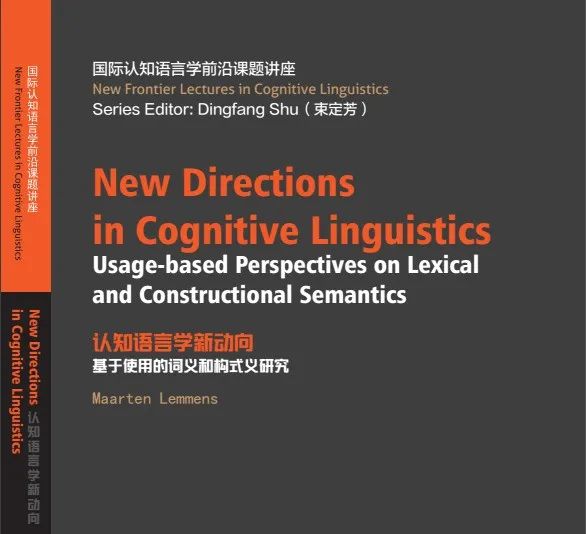963 阅读 2021-06-20 23:01:04 上传
以下文章来源于 英语语言学
国际认知语言学前沿课题讲座
New Frontier Lectures in Cognitive Lignuistics

ISBN:978-7-5446-6799-9
出版时间:2021年5月
作者:马尔腾·莱蒙斯 (Maarten Lemmens) 著
定价:65.00元(优惠价:45.50元)
丛书:国际认知语言学前沿课题讲座
//////////////////////
编辑推荐
“国际认知语言学前沿课题讲座”由中国认知语言学研究会与全国高校外语院校合作,组织国际认知语言学界知名学者在各高校做学术讲座,并精选讲座内容编撰而成,研究会会长束定芳教授任主编。丛书旨在鼓励和帮助我国年轻学者学习并获取相关领域国际最新信息、最前沿研究方法和技巧,从而促进其自身的科研发展。
丛书另已出版(点击下方书名查看):
《认知理论对三种英语倒装结构的统一阐释》 Rong Chen(陈融)
Maarten Lemmens是国际认知语言学领域的领军学者,多年来从事语言学研究,成果丰硕,影响深远。他是法国认知语言学协会的创立者和首任主席,曾任国际认知语言学协会主席、国际期刊CogniTextes主编,现任法国里尔大学教授。本书为其10次讲座的文字版,围绕认知语言学研究领域的诸多热点问题展开,对很多备受关注的语言词句和语言现象进行了深入浅出的分析和阐释。该系列讲座受到语言学研究者和高校师生的热烈欢迎,文字版将惠及更多读者。
●
●
●
●
●

Summary
The structure of the volume follows the original division into 10 different lectures. They fall apart in two larger blocks: the first part (comprising Lectures 1 and 2) presents the overall theoretical framework of cognitive, usage-based linguistics and its methodological consequences. The remaining part (Lectures 3 to 10) presents different case studies that I have carried out within this framework, some of these in collaboration with colleagues. They can be grouped in four large areas of research: (i) the study of lexical causatives in English (Lectures 3 and 4), (ii) posture and placement verbs in Dutch and English (Lectures 5, 6, 7 and 8), (iii) typological perspectives on spatial expressions (Lecture 9), and some particular grammaticalization studies (Lecture 10).
In somewhat more detail, the contents of this book can be summarized as follows. In Lecture 1, we present the basic tenets of a usage-based model of language, as adopted by a range of different theories (such as Langacker's Cognitive Grammar, Goldberg's Construction Grammar, Croft's Radical Construction Grammar, etc.) all united under the label ‘cognitive-functional theories of language’(see also Lemmens 2015, 2017a, 2019). We will show how such a model is committed to the view that language is non-autonomous, non-universal, symbolic, and conventional. We also clarify what is ‘cognitive’ about cognitive linguistics.
Lecture 2 will continue this theoretical discussion. In the first part, we will consider a major theoretical issue, viz. the characterization of constructions or symbolic units that are the only building blocks that the model allows. Secondly, we consider the more technical aspect of how a usage-based model actually works. Finally, we consider some methodological implications of taking a cognitive, usage-based perspective on language.

图/p. 59
Lectures 3 and 4 describe my lexical-paradigmatic approach to lexical causatives in English (first developed in Lemmens 1998a). Lecture 3 first presents this model which holds the view that the English grammar of causative verbs is governed by two general causative models, the transitive and the ergative paradigms. At the same time, we show how lexical features also play a role in explaining the syntactic alternations that lexical causatives occur in such as the causative alternation, e.g. He bounced the ball vs. The ball bounced (also called the unaccusative alternation). After presenting the general principles of the model, we will describe some case studies. The most recent one, focusing on the causative alternation, shows how corpus data can be exploited to evaluate two competing models to view syntactic alternations. As such, we not only provide some further insights into the lexical and constructional interface in the English grammar (cf. also Lemmens 1998a, b; 2005a; 2006a), but also show that the Generative and the Cognitive views may not be all that incompatible. Lecture 4 presents some diachronic case studies that illustrate how grammatical and lexical features interact in intricate ways in the domain of lexical causatives in English and their alternations. We show how individual uses of verbs may move into one paradigm while others are still situated in the other, or how a whole lexical field may shift from one causative paradigm to the other.
Lectures 5 to 9 are all related to cognitive analyses of expressions of static location. Lecture 5 presents a cognitive, lexical-semantic analysis of posture verbs in Dutch (see Lemmens 2002; Lemmens and Perrez 2010, 2012, 2018). This analysis reveals the semantic motivations that underlie the different uses of the posture verbs, including the idiomatic uses. We will show how the notion of image schemata is important to account for these uses. Also, we consider how different encodings represent different conceptualizations of one and the same reality.
Lecture 6 considers placement verbs which in many languages of the world align with posture verbs (see Lemmens 2006b, Atintono and Lemmens 2013). We first consider Talmy's three aspectual types and how different languages have different preferences in their lexicalization patterns. We then consider in more detail how placement verbs relate to posture verbs in the Germanic languages. Again, Dutch appears to be the language that has the most extensive use of placement verbs and as such provides an interesting case study.
Lecture 7 builds on the previous analyses of posture verbs in different languages and illustrates how in several languages these posture verbs have grammaticalized to aspectual markers. In the second part of the lecture, we will take up Dutch again for a more detailed case study and consider the (partial) grammaticalization of the Dutch posture verbs toward progressive auxiliaries (cf. Lemmens 2005b, 2015, 2017b). Our corpus-based analysis reveals subtle semantic differences between some of these ‘posture-less’ progressives and another common progressive construction in Dutch (aan het V zijn ‘be at the V’). In more general terms, this lines up with the general view that differences of construction reveal differences in meaning.
In Lecture 8, we present a short description of some diachronic evolutions of posture and placement verbs in the Germanic languages (see Lemmens 2006b, Lemmens and David 2006). More particularly, we will consider some of the disturbances that have arisen in the originally very neat opposition. Strikingly, English stands out, again, as being least Germanic; we suggest some hypotheses for this peculiar evolution (see Lemmens 2014, Lesuisse and Lemmens 2018).
Lecture 9 takes a larger perspective on locative expressions. Within the framework of Talmy's (2000) typological distinction between Satellite- and Verb-framed languages, the lecture reports on results from an on-going project on of static locative relationships as expressed by verbs in English, French, and Dutch (see also Lemmens 2005c; Lemmens and Perrez 2010, 2012, 2018). The data analyzed is drawn from picture descriptions where subjects were asked to talk about the location of certain entities on these pictures.

图/p. 300
As we will show, Talmy's views need to be revised in view of the fact that some Satellite-framed languages, such as Dutch (but also German and Swedish) use four basic verbs (‘sit’, ‘lie’, ‘stand’, and ‘hang’) to refer to (canonical) location. This has considerable consequences for the attention that speakers attribute to location as well as where in the sentence they express it. In addition, the results reveal that French does mention manner of location if it is salient, but also that it has a strong hook-up with attachment. Further differences seem to surface at discourse level, revealing different ways of presenting locative information. A last area that we will briefly touch upon is the use of co-verbal gesture. Exploratory analysis (still ongoing, see Lemmens and Perrez 2015, 2017) suggests that the gestures do differ across the languages, especially in shape, and that they often encode information that remains unexpressed in the verbal productions. The data also indicate that gestures are influenced by the speaker's verbal proficiency.
Finally, in Lecture 10, we discuss two small case studies on grammaticalization. The first one concerns the on-going process of grammaticalization of OK (and variants, such as O.K., okay, etc.) in English, Swedish and Dutch. Our corpus analysis for English reveals that OK has undergone a three-step grammaticalization from its first occurrence (early 19th century) till the present day, and that this process is still continuing. Strikingly, our Dutch and Swedish corpora show that OK, as a loanword from English, echoes the same grammaticalization steps as those in English, but do so some decades later. We will also consider the parallel evolution of other evaluative phrases, in particular the grammaticalization of the French loanword ça va (litt. ‘it goes') in Belgian Dutch.
The second study concerns so-called light verb constructions in Odia, an Indo-Aryan language, spoken predominantly in Odisha, an eastern state in India. These light verbs occur in asymmetric complex predicates, combining a main verb and a fully or partially bleached ‘light' verb (‘go', ‘give', ‘drop', etc.), where the main verb carries the lexical semantic information. As we will show, the light verbs affect the interpretation of the event in (usually) two ways: (i) they express completion of the event and (ii) unexpectedness or abruptness.
The research presented in this volume represents the large strands of research that I have been working on in the course of my career. What is common to all these strands is that they all use a cognitive usage-based perspective on language. It is therefore warranted that we open this volume with two lectures that present this theoretical model.
(《认知语言学新动向》,pp. 1-5)
Contents
Summary
Lecture 1 Introduction to a cognitive view on language
1.1 Basic postulates of cognitive linguistics
1.2 The structure of grammar
1.3 The emergence of grammar: a usage-based view
1.4 What is cognitive about cognitive linguistics?
1.5 Concluding remarks
Lecture 2 Usage-based linguistics and its methodological consequences
2.1 Introduction
2.2 A constructional view on linguistic knowledge
2.3 Defining constructions
2.4 From constructs to constructions
2.5 From usage to grammar and back
2.6 Concluding remarks
Lecture 3 Lexical-paradigmatic analysis of lexical causatives (synchronic perspective)
3.1 The lexical-paradigmatic approach
3.2 Case study 1: The (transitive) objectless construction
3.3 Case study 2: The causative alternation
3.4 Concluding remarks
Lecture 4 Lexical-paradigmatic analysis of lexical causatives (diachronic perspective)
4.1 Introduction
4.2 The ergativization of intransitives
4.3 The ergativization of transitives
4.4 Some particular paradigmatic changes
4.5 Concluding remarks
Lecture 5 A cognitive lexical semantic analysis of posture verbs
5.1 Introduction
5.2 A cognitive account of (Dutch) posture verbs
5.3 A look at learner language
5.4 Posture verbs in other languages
5.5 Concluding remarks
Lecture 6 A cognitive lexical semantic analysis of placement verbs
6.1 Posture and placement verbs
6.2 Aspect-causative lexicalization patterns
6.3 Dutch placement verbs
6.4 Concluding remarks
Lecture 7 Grammaticalization of (Dutch) posture verbs to grammatical markers
7.1 From spatial to progressive
7.2 Locational progressive constructions in Dutch
7.3 Comparison of POS and PREP progressives
7.4 Concluding remarks
Lecture 8 Diachronic perspectives on posture and placement verbs
8.1 Posture verbs in Germanic languages
8.2 The demise of posture verbs in English
8.3 The demise of set and the rise of put
8.4 Concluding remarks
Lecture 9 Typological perspectives on location
9.1 Typological perspectives on motion and location
9.2 Cross-linguistic differences in locative expressions
9.3 Concluding remarks
Lecture 10 Two case studies in grammaticalization
10.1 From particle to evaluative adjective
10.2 Light verbs in Odia
10.3 Concluding remarks
Bibliography
Appendices
Appendix 1: List of texts for pilot study on English sit (Lecture 8)
Appendix 2: List of texts for the rise of English put (Lecture 8)
Appendix 3: Pictures used in the Oral Picture Description Experiment (Lecture 9)

【互 动 赠 书】
欢迎文末留言
或者转发集赞21个,截图发至后台
我们将从中随机抽取3名幸运读者
各赠送本期推荐新书《认知语言学新动向:基于使用的词义和构式义研究》1本
(统计截止时间为推送发出后的下周五中午12点)
机会多多,不要错过哦!
(ps. 小编已经联系之前的获奖读者,请您看到消息后及时回复寄送信息,我们会尽快寄出赠书)
end













